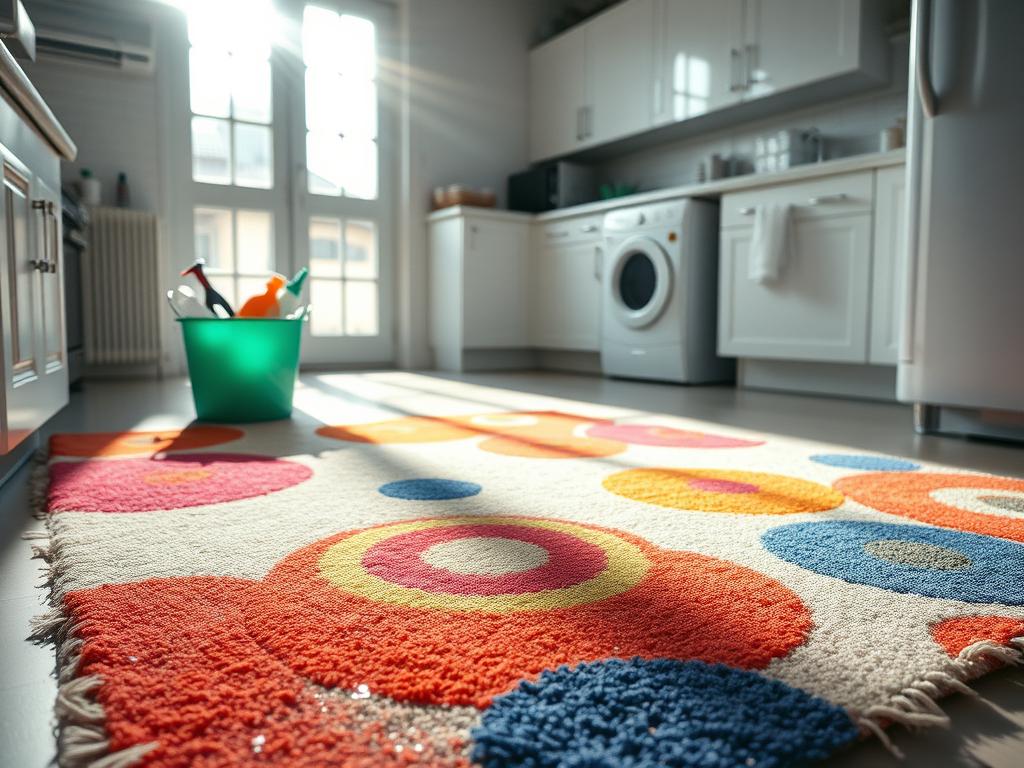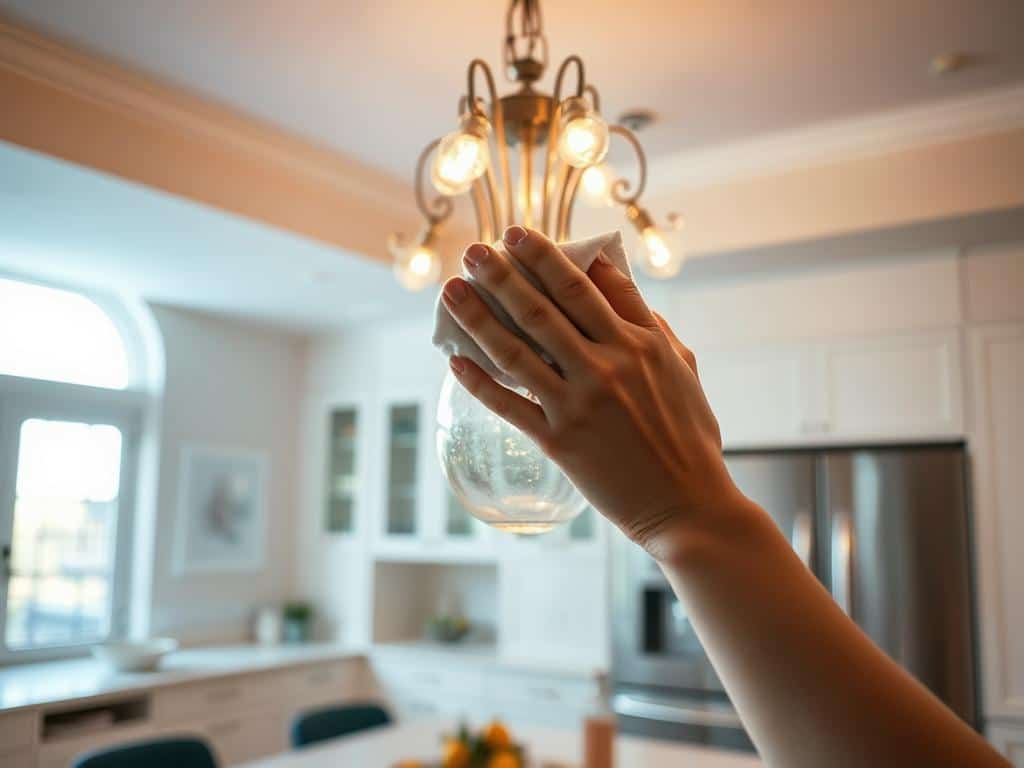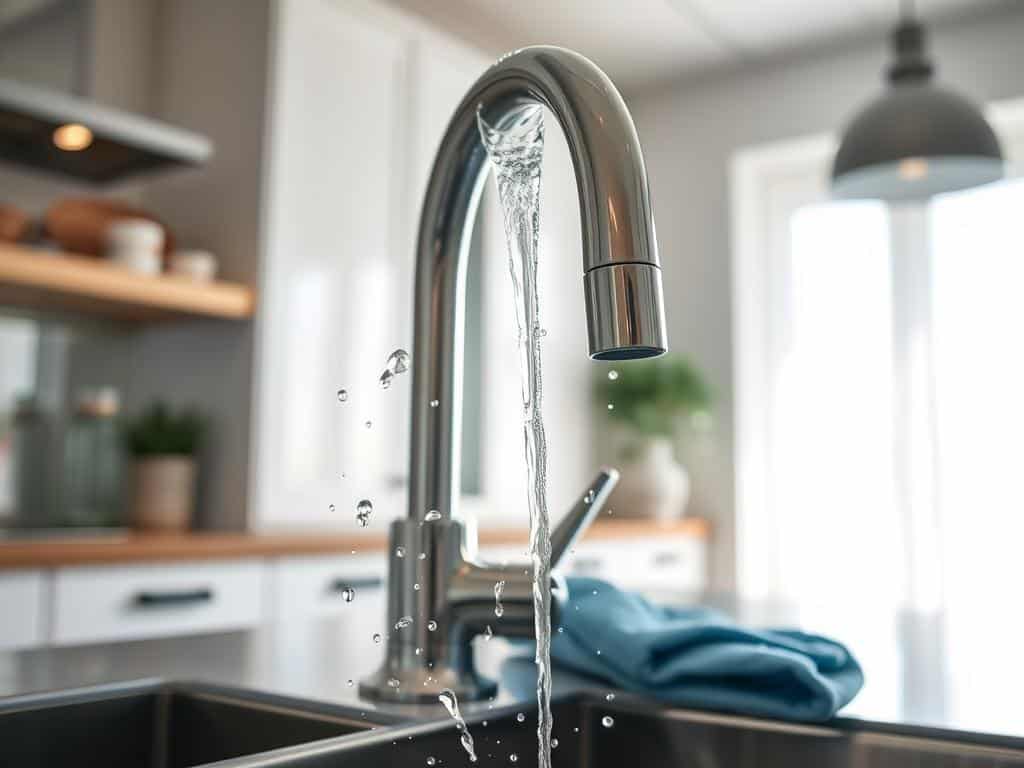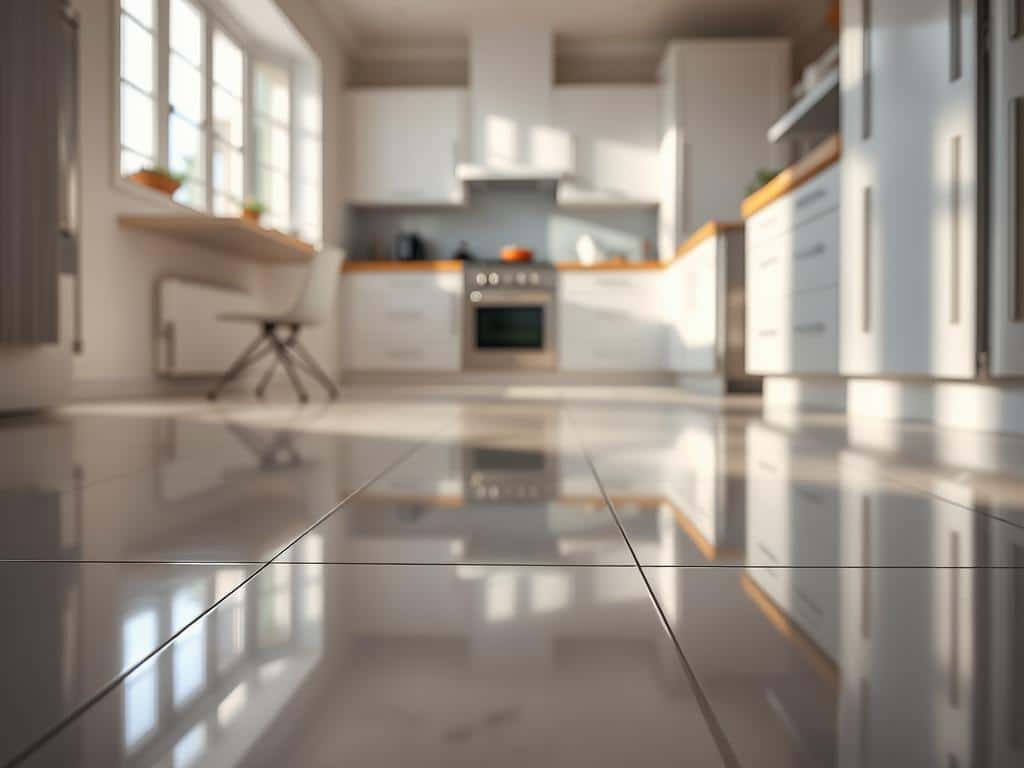
Tackling kitchen floor tiles might seem daunting, but with the right approach, they can be made to shine with minimal effort. Regular sweeping or vacuuming plays a crucial role in maintaining the sparkle of ceramic and porcelain tiles, as does the avoidance of sponge mops which can dirty grout lines. Opt for mild detergent solutions or a dash of dish soap in water for efficient and harmless cleaning. For polished tiles, promptly drying off is key to preventing water spots. Living rooms, known for higher traffic, might require more frequent cleaning compared to other areas.
Using gentle, effective methods is the cornerstone of this tile cleaning guide. Regular maintenance routines, such as employing a mixture of mild detergent and warm water, keep your tiles looking their best. This holds true for all types of tile materials, whether you have ceramic, porcelain, or natural stone tiles.
Moreover, incorporating a combination of preventive measures like using doormats and promptly addressing spills contributes significantly to your kitchen tile maintenance.
Utilize proper cleaning solutions tailored to your specific tile material. For instance, ceramic and porcelain tiles can withstand more abrasive cleaning agents, while natural stone requires gentler solutions. For a deeper dive into maintaining matte porcelain tiles, learn more here.
Introduction to Cleaning Kitchen Floor Tiles
Tiles have long been a favored choice for kitchen floors because of their durability and appealing variety. Achieving immaculate kitchen tiles goes beyond simply mopping; it encompasses understanding the type of tile and the best cleaning methods for each.
Porcelain tiles, for instance, are more challenging for DIY enthusiasts to cut and install due to their harder material and higher firing temperatures. However, their strength makes them a popular choice for both indoor and outdoor floors. Ceramic tiles, on the other hand, are the most commonly used due to their durability and easy tile maintenance.
Quarry tiles, made from natural clay and pulverized stone, offer superior resistance to water compared to terra cotta tiles. Regular wet cleaning every two weeks and grout cleaning are essential in keeping tile floors pristine and hygienic. Additionally, routine mopping and wiping help prevent grime buildup and maintain cleanliness.
The choice of cleaning tools also plays a significant role. Using a microfiber or chamois mop instead of a sponge mop is advisable as it prevents pushing dirt into grout lines. For effective grout cleaning, a baking soda paste is beneficial for stained grout, while avoiding steam cleaners to prevent long-term damage. Periodic deep cleaning every few months is recommended to maintain tile floors in prime condition.
When dealing with marble and natural stone tiles, specific maintenance strategies are necessary to preserve their elegance. These materials typically need a neutral pH cleaner to prevent damage. Likewise, vinyl and linoleum floors require careful selection of cleaning solutions to avoid scratching, making them a low-maintenance and affordable kitchen flooring option.
The opaсity of tiles and the condition of grout are key indicators of whether further cleaning is needed beyond routine maintenance. Employing methods such as sealing grout joints helps keep stains and moisture at bay. Likewise, drying the floor properly after wet cleaning is crucial to prevent mold and bacteria development in grout lines.
In recent years, products like Swiffer Wet Cloths have become popular for cleaning a variety of surfaces, including vinyl, porcelain, and ceramic tiles. Mixing water and vinegar in equal parts is also a suggested natural solution for disinfecting and cleaning kitchen floors effectively.
Understanding these nuances will help you maintain immaculate kitchen tiles, ensuring a sparkling and hygienic kitchen environment. Regular sweeping, mopping, and targeted grout cleaning ultimately lead to easy tile maintenance, preserving the luster and lifespan of your kitchen floor tiles.
Essential Tools and Supplies for Cleaning Kitchen Floor Tiles
Maintaining clean kitchen floor tiles is essential for hygiene and aesthetic appeal. Selecting the appropriate tools and supplies ensures you achieve optimal results with minimal effort. This section highlights the crucial tools you need and the best cleaning solutions for different types of tiles.
Choosing the Right Mop
When it comes to mops for tile floors, selecting the right type is crucial. Chamois mops are excellent for avoiding dirty grout lines, ensuring a cleaner finish without additional grime. It’s important to note that not all mops are suitable for every tile material. For instance, using specialized mops designed for different tile surfaces can significantly improve your cleaning efficacy. A long-handled deck brush can also be highly effective in removing dirt and grime from tiles while allowing you to clean comfortably without kneeling.
Effective Cleaning Solutions
Finding the right tile cleaners for your kitchen floor tiles depends on the tile material. For ceramic tile floors, a mixture of warm water and mild dish soap works wonders. Porcelain tiles, especially unpolished ones, can be cleaned using a blend of vinegar and warm water for optimal results. Natural stone tiles like slate, granite, marble, and travertine require special care; avoid acidic substances such as vinegar, as they can damage the surface.
For tough grout stains, consider using a baking soda and water paste or a solution of bleach and water for particularly stubborn spots. Remember to avoid contact with the tiles while applying these solutions. Grout restoration is crucial, so reseal grout annually to maintain its protective layer, and spot-clean it every two to three months to keep your tiles looking polished and new. By carefully choosing tile cleaners and maintaining grout, your kitchen floor tiles will remain pristine and hygienic for years to come.
Step-by-Step Guide to Cleaning Kitchen Floor Tiles
Maintaining a clean kitchen floor is crucial for both hygiene and aesthetics. Follow this comprehensive, step-by-step guide to ensure your tiles remain spotless and in top condition.
Pre-cleaning Steps: Sweeping and Vacuuming
Before you begin the deep cleaning process, it’s essential to sweep and vacuum your kitchen floor. According to the Tile Council of North America, not cleaning up spills immediately can lead to over 70% more staining on tile surfaces. Start by removing excess dirt and debris to prevent scratching during mopping. Sweep thoroughly and use a vacuum to pick up particles left behind.
Cleaning Different Types of Tiles
Different types of tiles require specific care to maintain their unique qualities:
- Ceramic and Porcelain Tiles: These are durable and moisture-resistant. Mix ¼ cup of mild detergent into 1 gallon of water for an effective cleaning solution. A 1:1 solution of white vinegar and water can also be used.
- Vinyl Tiles: Made from PVC, these can be cleaned with rubbing alcohol or baking soda to remove scuff marks.
- Linoleum Tiles: Avoid high moisture levels and steam mops. These tiles can be wiped with a mild cleaner to avoid damage.
- Natural Stone Tiles: Given their porous nature, these require specific cleaners. Avoid acid-based cleaners and opt for a solution tailored to the stone type for natural stone care.
Post-cleaning Steps: Drying and Buffing
After mopping, it’s vital to dry the tiles to avoid water spots, especially on streak-free tile finish materials like slate and marble. Use a clean, dry cloth to wipe the floor thoroughly. Buffing the tiles occasionally can restore the original sheen, particularly on granite tiles. For a streak-free tile finish, ensure that any residue from the cleaning solution is completely removed before drying.
Based on a University of Arizona study, traditional mopping methods leave significant amounts of bacteria behind. Therefore, effective cleaning solutions and methods are essential. Vacuuming or sweeping should be done a few times a week, and mopping every one to two weeks. Maintaining regular cleaning habits will ensure your kitchen floor tiles remain hygienic and attractive.
Tips for Maintaining Your Clean Kitchen Floor Tiles
Maintaining the cleanliness and longevity of your kitchen floor tiles is crucial not just for aesthetics but also for health and safety. Regular tile maintenance ensures that your kitchen remains a vibrant and hygienic space for food preparation and family gatherings.
Considering the type of tile you have is essential. For example, ceramic and porcelain tiles are renowned for their durability and versatility, making them easier to clean and maintain. On the other hand, natural stone tiles like marble and granite require extra care due to their porous nature. These natural stone tiles often need to be sealed periodically to resist stains and make cleaning more manageable.
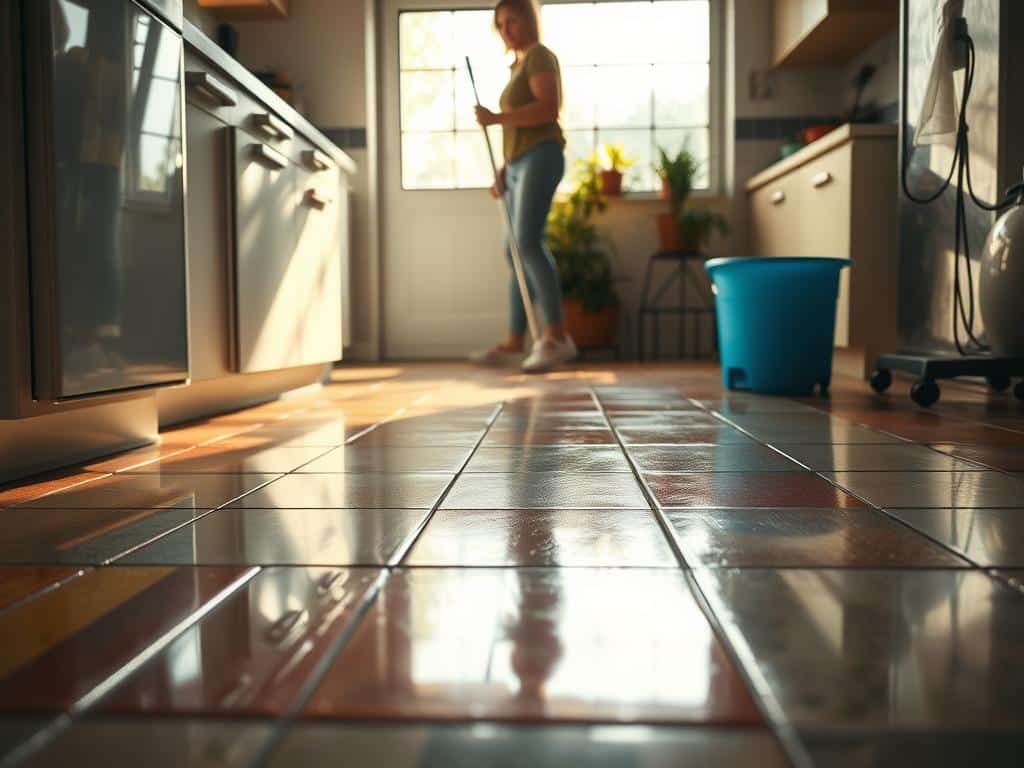
To keep your kitchen floors in pristine condition, it’s recommended to adopt a regular cleaning frequency. Daily sweeping or vacuuming is critical to remove loose dirt and grit that can scratch tile surfaces. For deeper cleaning, mopping with a microfiber mop every one to two weeks helps eliminate stuck-on grime without leaving residue.
Grout protection is another important aspect of tile maintenance. Grout lines, especially in high-traffic areas like kitchens, can easily become stained and discolored. Sealing the grout creates a barrier that prevents liquids from penetrating and causing stains. Periodic grout cleaning, ideally every few months, can keep your tiles looking immaculate.
| Tile Type | Main Advantage | Recommended Maintenance |
|---|---|---|
| Ceramic & Porcelain | Durable & Moisture-resistant | Sweep daily, mop every 1-2 weeks |
| Natural Stone | Luxurious, Unique patterns | Seal regularly, avoid acidic cleaners |
| Vinyl | Affordable & Waterproof | Daily sweeping, occasional mopping |
| Laminate | Cost-effective & Scratch-resistant | Sweep frequently, avoid water pooling |
Adopting preventive measures can also extend the life of your kitchen tiles. Using doormats to trap dirt, removing shoes before entering, and promptly cleaning spills can all reduce wear and tear. For those who want a professional touch, services like Steamy Concepts offer thorough cleaning and restoration to maintain the original luster of your tiles.
In conclusion, understanding your tile’s needs and sticking to a regular cleaning schedule can keep them looking fresh and new for years to come. Whether it’s daily sweeping or periodic grout sealing, every step you take in tile maintenance contributes to a cleaner, more beautiful kitchen.
Conclusion
The journey to immaculate and beautiful kitchen floors begins with understanding your tile material and embracing the appropriate cleaning regimen. A consistent tile cleaning routine is pivotal, not only in preserving the tiles’ luster but also in extending their longevity. Daily maintenance through sweeping or vacuuming lays the groundwork for easier and more effective periodic cleanings.
Incorporating varying cleaning solutions tailored to different floor types can be a game-changer. For instance, a vinegar and water solution is often recommended for tile floors, while wooden floors benefit from pH-neutral cleaners. Moreover, categorizing your efforts into daily upkeep, spot cleaning, and monthly deep cleaning ensures that your kitchen floor remains spotless and well-maintained. It’s essential to prioritize grout care as part of this routine; regular attention to grout lines can significantly enhance the overall appearance of your floor, keeping it looking fresh and new.
For those seeking an innovative and highly efficient method, consider using an ultrasonic cleaner. This technology is renowned for its precision, eco-friendliness, and time efficiency, making it an excellent alternative to traditional methods. By embracing these strategies and tools, you can achieve pristine kitchen floors effortlessly. For a more comprehensive guide on this technology and its application, visit this resource for detailed insights.

